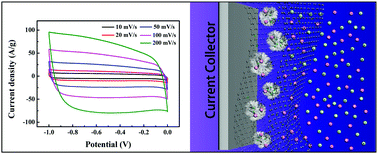Silicon quantum dot-assisted synthesis of MoS2/rGO sandwich structures with excellent supercapacitive performance†
Abstract
Layered molybdenum disulfide (MoS2) has shown potential as an electrode material towards high-performance supercapacitors. Structural engineering of MoS2-based nanocomposites could further improve their electrochemical response. In this work, a unique architecture composed of 3D MoS2 nanoflowers sandwiched between 2D reduced graphene oxide (rGO) nanosheets is obtained by a facile hydrothermal method with the assistance of silicon quantum dots (SiQDs). The resultant SiQDs-MoS2/rGO possesses large surface areas, abundant active sites and diversified pores. In addition, the MoS2 component contains a high content of metallic 1T phase besides the intrinsic semiconductive 2H phase, leading to increased electrical conductivity. This work reveals that the introduced SiQDs as an exogenous seed can regulate the crystal growth and morphological evolution of MoS2 in the presence of rGO. Consequently, the resulting SiQDs-MoS2/rGO electrode for supercapacitors exhibits a high specific capacitance (946.7 F g−1 at 0.5 A g−1), an impressive cycling stability (88.2% capacitance retention after 10 000 cycles), as well as an excellent energy density of 71.3 W h kg−1 and a power density of 11.3 kW kg−1. The sandwich structure together with the synergistic effects of each active component contributes to the excellent electrochemical performance of SiQDs-MoS2/rGO. This work provides a simple yet effective approach for the preparation of high-performance MoS2-based electrode materials for supercapacitors.



 Please wait while we load your content...
Please wait while we load your content...